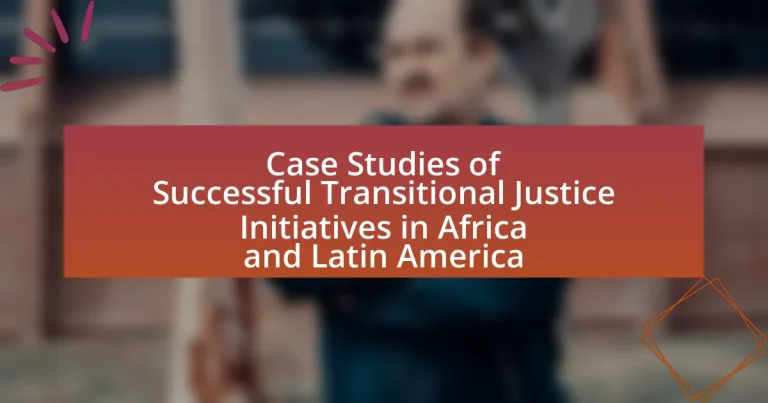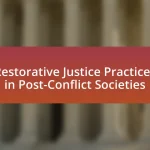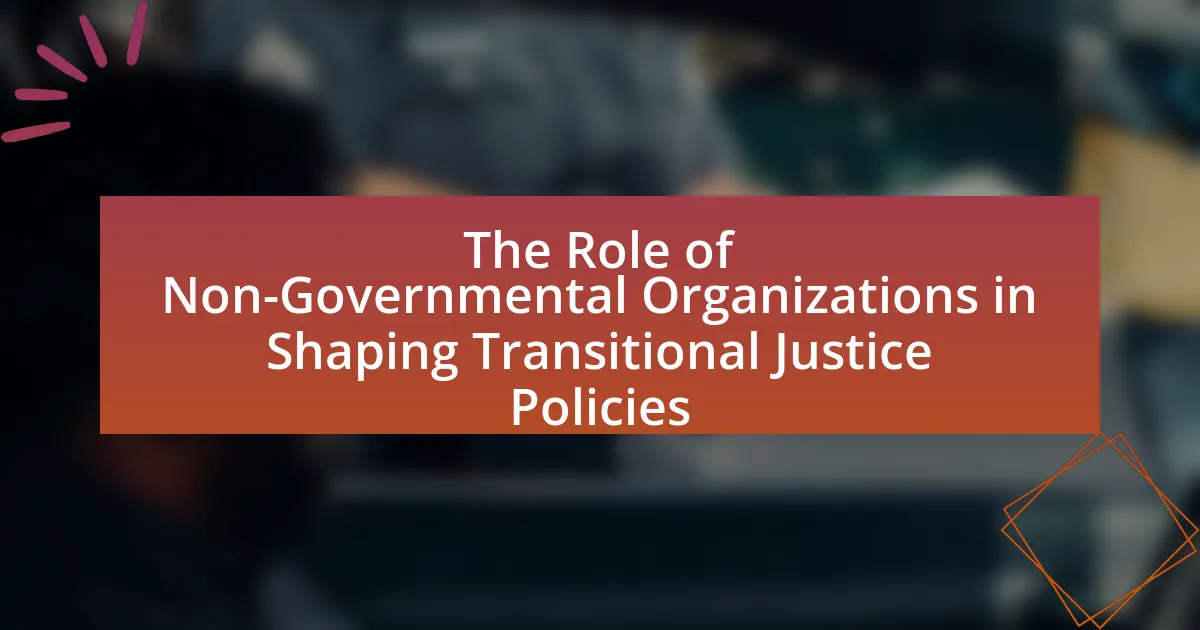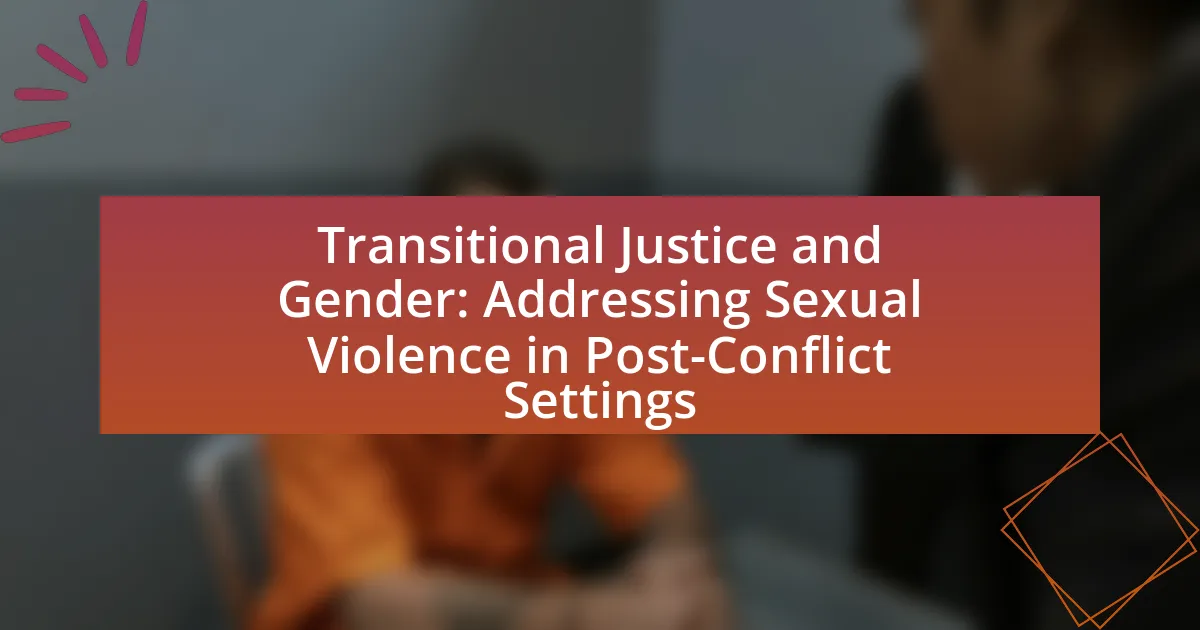Transitional Justice Initiatives in Africa and Latin America are critical processes designed to address past human rights violations and foster accountability, reconciliation, and healing in societies emerging from conflict or authoritarian regimes. This article examines notable case studies, such as South Africa’s Truth and Reconciliation Commission and Argentina’s National Commission on the Disappearance of Persons, highlighting their mechanisms, including truth commissions, reparations, and legal accountability measures. It also explores the key components of successful initiatives, the role of political will and civil society, and the best practices that can inform future transitional justice efforts, while identifying common pitfalls to avoid in implementation.
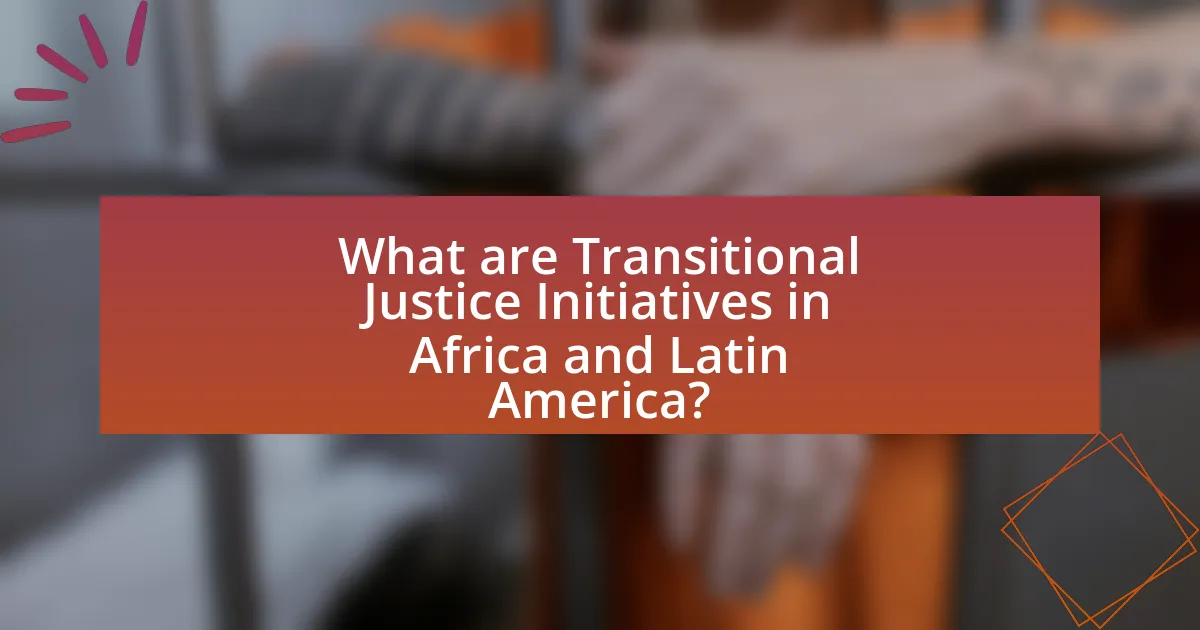
What are Transitional Justice Initiatives in Africa and Latin America?
Transitional Justice Initiatives in Africa and Latin America are processes aimed at addressing past human rights violations and promoting accountability, reconciliation, and healing in societies transitioning from conflict or authoritarian rule. These initiatives often include mechanisms such as truth commissions, reparations programs, and judicial proceedings to investigate and prosecute perpetrators of crimes against humanity. For example, South Africa’s Truth and Reconciliation Commission, established in 1995, sought to uncover the truth about apartheid-era abuses and foster national unity, while in Argentina, the National Commission on the Disappearance of Persons (CONADEP) documented human rights violations during the military dictatorship from 1976 to 1983, leading to legal actions against perpetrators. These initiatives are crucial for restoring trust in institutions and ensuring that victims’ voices are heard, thereby contributing to long-term peace and stability in the region.
How do these initiatives address past human rights violations?
These initiatives address past human rights violations by implementing mechanisms such as truth commissions, reparations programs, and legal accountability measures. Truth commissions, like South Africa’s Truth and Reconciliation Commission, uncover the truth about past abuses, allowing victims to share their experiences and fostering national healing. Reparations programs, as seen in countries like Argentina, provide financial compensation and support to victims, acknowledging their suffering and promoting restorative justice. Legal accountability measures, including trials for perpetrators, serve to deter future violations and reinforce the rule of law, as demonstrated by the International Criminal Court’s prosecutions. Collectively, these approaches aim to acknowledge past injustices, promote healing, and prevent recurrence of violations.
What are the key components of successful transitional justice initiatives?
Successful transitional justice initiatives typically include truth-seeking, accountability, reparations, and institutional reform. Truth-seeking mechanisms, such as truth commissions, help uncover the facts about past human rights violations, fostering public acknowledgment and understanding. Accountability is achieved through legal processes that hold perpetrators responsible, which can deter future violations and promote rule of law. Reparations provide recognition and compensation to victims, addressing their suffering and aiding in their recovery. Institutional reform focuses on restructuring state institutions to prevent recurrence of abuses, ensuring that justice systems are fair and effective. These components have been evidenced in various case studies, such as South Africa’s Truth and Reconciliation Commission, which successfully combined these elements to address apartheid-era injustices.
How do these components interact to promote healing and reconciliation?
The components of transitional justice, including truth-telling, reparations, and institutional reform, interact synergistically to promote healing and reconciliation. Truth-telling allows victims to share their experiences, fostering acknowledgment of past injustices, which is essential for emotional healing. Reparations provide tangible recognition of suffering, helping to restore dignity and support recovery. Institutional reform addresses systemic issues that contributed to violence, ensuring accountability and preventing future abuses. Together, these components create a comprehensive framework that not only addresses the needs of victims but also promotes societal healing by rebuilding trust in institutions and encouraging dialogue among communities. This interaction is evidenced by successful initiatives in countries like South Africa and Colombia, where these elements have led to significant strides in reconciliation and social cohesion.
Why are case studies important for understanding transitional justice?
Case studies are important for understanding transitional justice because they provide concrete examples of how different societies have addressed past human rights violations and built mechanisms for accountability and reconciliation. By examining specific instances, such as South Africa’s Truth and Reconciliation Commission or Argentina’s trials for human rights abuses, researchers can analyze the effectiveness of various approaches, identify best practices, and understand the socio-political contexts that influence outcomes. These detailed examinations reveal the complexities and challenges of implementing transitional justice, offering insights into the factors that contribute to successful or failed initiatives.
What insights can be gained from analyzing specific case studies?
Analyzing specific case studies of successful transitional justice initiatives in Africa and Latin America provides insights into effective strategies for reconciliation and accountability. These case studies reveal how tailored approaches, such as truth commissions and reparations, can address historical injustices and foster social cohesion. For instance, the Truth and Reconciliation Commission in South Africa demonstrated that public testimonies can facilitate healing and promote national unity, as evidenced by the significant reduction in violence post-apartheid. Additionally, the case of Guatemala’s Historical Clarification Commission illustrates the importance of documenting human rights violations to validate victims’ experiences and inform policy changes. Such analyses underscore the necessity of context-specific solutions in transitional justice processes, highlighting both successes and challenges faced by different nations.
How do case studies illustrate the challenges and successes of transitional justice?
Case studies illustrate the challenges and successes of transitional justice by providing concrete examples of how different countries have navigated the complexities of addressing past human rights violations. For instance, the Truth and Reconciliation Commission in South Africa successfully facilitated dialogue and healing after apartheid, demonstrating the potential for restorative justice to foster national unity. Conversely, the case of Guatemala reveals challenges, such as ongoing impunity and societal divisions, which hinder the effectiveness of transitional justice mechanisms. These examples highlight that while transitional justice can lead to significant societal change, it often faces obstacles like political resistance and lack of resources, as seen in the struggles of the Guatemalan justice system to prosecute war crimes.
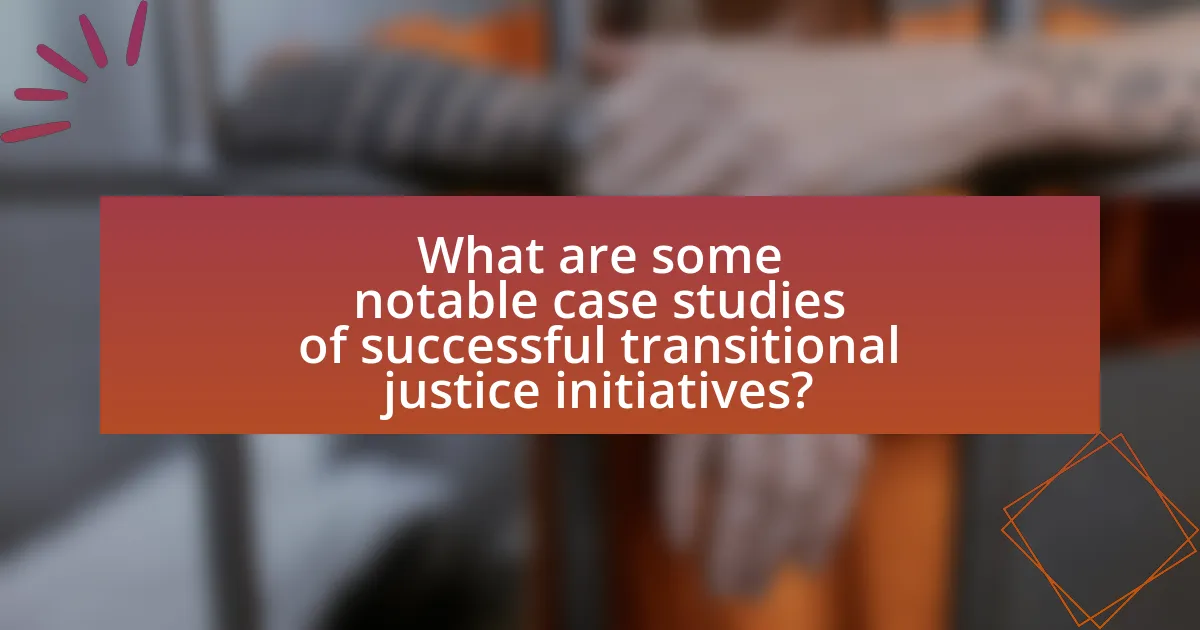
What are some notable case studies of successful transitional justice initiatives?
Notable case studies of successful transitional justice initiatives include South Africa’s Truth and Reconciliation Commission (TRC) and the Guatemalan Historical Clarification Commission. The TRC, established in 1995, aimed to address human rights violations during apartheid by promoting national healing through public testimonies and reparations, leading to a greater understanding of the past and fostering reconciliation. The commission documented over 21,000 human rights violations and provided a platform for victims to share their experiences, contributing to a more inclusive national narrative.
In Guatemala, the Historical Clarification Commission, formed in 1997, investigated human rights abuses during the civil war from 1960 to 1996. The commission’s 1999 report concluded that the state was responsible for 93% of the violations, which helped to acknowledge the suffering of victims and laid the groundwork for legal accountability. These initiatives demonstrate the effectiveness of transitional justice in promoting healing and accountability in post-conflict societies.
How did South Africa’s Truth and Reconciliation Commission operate?
South Africa’s Truth and Reconciliation Commission (TRC) operated as a restorative justice body established in 1995 to address the human rights violations that occurred during apartheid. The TRC facilitated public hearings where victims and perpetrators could share their experiences, aiming to uncover the truth about past atrocities and promote national healing. It operated under the Promotion of National Unity and Reconciliation Act, which provided legal frameworks for granting amnesty to individuals who fully disclosed their involvement in politically motivated crimes. The commission’s findings were documented in a series of reports, which highlighted systemic injustices and recommended measures for reparations and institutional reforms, thereby contributing to the country’s transition to democracy.
What were the main goals of the Truth and Reconciliation Commission?
The main goals of the Truth and Reconciliation Commission were to uncover the truth about human rights violations that occurred during apartheid in South Africa, promote national healing, and foster reconciliation among divided communities. The Commission aimed to document the experiences of victims and perpetrators, provide a platform for public testimony, and recommend measures for reparations and institutional reforms. Established in 1995, the Commission’s findings were intended to acknowledge past injustices and facilitate a peaceful transition to a democratic society, thereby addressing the legacy of violence and promoting social cohesion.
What outcomes resulted from the commission’s work?
The outcomes from the commission’s work included the establishment of accountability for human rights violations, the promotion of truth-telling, and the facilitation of reconciliation processes within affected communities. These results were evidenced by the successful documentation of abuses, which led to legal actions against perpetrators and the acknowledgment of victims’ suffering. Additionally, the commissions often contributed to the creation of policies aimed at preventing future violations, thereby fostering a more stable and just society.
What lessons can be learned from the Guatemalan peace process?
The Guatemalan peace process teaches the importance of inclusive dialogue and the need for addressing root causes of conflict. This process, which culminated in the 1996 Peace Accords, involved various stakeholders, including the government, guerrilla groups, and civil society, highlighting that broad participation is crucial for sustainable peace. Additionally, the process emphasized the significance of truth-telling and accountability, as seen in the establishment of the Commission for Historical Clarification, which documented human rights violations. This documentation served to acknowledge victims’ suffering and foster reconciliation, demonstrating that addressing historical injustices is vital for long-term stability.
How did the peace accords address historical injustices?
The peace accords addressed historical injustices by establishing mechanisms for truth-telling, reparations, and institutional reforms. These accords often included provisions for truth commissions, which documented human rights violations and acknowledged the suffering of victims, thereby validating their experiences. For instance, the Truth and Reconciliation Commission in South Africa was a key component of the peace process, allowing victims to share their stories and promoting national healing. Additionally, the accords typically mandated reparations for victims, which could include financial compensation, access to healthcare, and educational opportunities, aimed at restoring dignity and addressing the socio-economic disparities caused by past injustices. Furthermore, institutional reforms were often implemented to prevent the recurrence of such injustices, including changes in law enforcement and judicial systems to ensure accountability and uphold human rights.
What role did community involvement play in the success of the process?
Community involvement was crucial in the success of transitional justice processes in Africa and Latin America. Engaging local populations fostered trust, ensured that the initiatives were culturally relevant, and facilitated the identification of key issues that needed addressing. For instance, in South Africa’s Truth and Reconciliation Commission, community participation allowed victims to share their stories, which not only validated their experiences but also contributed to national healing and reconciliation. This active involvement led to higher acceptance rates of the processes and outcomes, as evidenced by public surveys indicating strong support for the initiatives when communities felt included.

What factors contribute to the success of transitional justice initiatives?
The success of transitional justice initiatives is primarily influenced by the establishment of inclusive political processes, public participation, and the commitment of both local and international actors. Inclusive political processes ensure that diverse voices are represented, fostering legitimacy and trust in the initiatives. For example, in South Africa, the Truth and Reconciliation Commission involved various stakeholders, which helped to address grievances and promote national healing. Public participation enhances community ownership and accountability, as seen in the participatory approaches adopted in the Guatemalan peace process, where local communities were actively engaged in discussions about justice and reparations. Furthermore, the commitment of local and international actors, including governments, NGOs, and international organizations, is crucial for providing resources, expertise, and support, as demonstrated by the involvement of the United Nations in various transitional justice efforts across Latin America. These factors collectively contribute to the effectiveness and sustainability of transitional justice initiatives.
How does political will influence the effectiveness of these initiatives?
Political will significantly influences the effectiveness of transitional justice initiatives by determining the level of commitment and resources allocated to these processes. When political leaders prioritize transitional justice, they are more likely to enact necessary reforms, support legal frameworks, and ensure the participation of affected communities. For instance, in South Africa, the political will demonstrated by Nelson Mandela and the African National Congress facilitated the establishment of the Truth and Reconciliation Commission, which played a crucial role in addressing past human rights violations. This commitment led to greater public trust and engagement, ultimately enhancing the initiative’s effectiveness in promoting healing and reconciliation.
What examples demonstrate the impact of political support on transitional justice?
Political support significantly impacts transitional justice, as evidenced by the cases of South Africa and Colombia. In South Africa, the political backing of Nelson Mandela and the African National Congress facilitated the establishment of the Truth and Reconciliation Commission, which addressed past human rights violations and promoted national healing. This political endorsement was crucial in legitimizing the process and encouraging public participation. Similarly, in Colombia, the 2016 peace agreement between the government and the Revolutionary Armed Forces of Colombia (FARC) was bolstered by strong political support from President Juan Manuel Santos, leading to the creation of a comprehensive transitional justice framework that included truth commissions and reparations for victims. This political commitment was essential for the implementation of justice measures and fostering societal trust in the process.
How can lack of political will hinder progress?
Lack of political will can significantly hinder progress by obstructing the implementation of necessary reforms and policies. When political leaders do not prioritize or support transitional justice initiatives, it leads to stalled processes, inadequate funding, and insufficient legal frameworks. For instance, in countries like Argentina and South Africa, the success of transitional justice was heavily reliant on the commitment of political leaders to address past human rights violations. Without their backing, efforts to establish accountability and reconciliation can falter, resulting in continued societal divisions and unresolved grievances. This demonstrates that political will is crucial for mobilizing resources and fostering an environment conducive to meaningful change.
What role does civil society play in transitional justice initiatives?
Civil society plays a crucial role in transitional justice initiatives by advocating for accountability, promoting human rights, and facilitating community engagement. Organizations within civil society often serve as intermediaries between victims and the state, ensuring that the voices of marginalized groups are heard in the justice process. For instance, in South Africa, civil society organizations were instrumental in the Truth and Reconciliation Commission, which aimed to address past human rights violations and foster national healing. Their involvement helped to document testimonies, raise public awareness, and push for policy changes that supported justice and reconciliation. This active participation underscores the importance of civil society in shaping effective transitional justice frameworks that reflect the needs and aspirations of affected communities.
How do grassroots movements contribute to the success of these initiatives?
Grassroots movements significantly enhance the success of transitional justice initiatives by mobilizing community support and fostering local ownership of the processes. These movements engage citizens directly, ensuring that the voices of marginalized groups are heard, which is crucial for legitimacy and effectiveness. For instance, in South Africa, the Truth and Reconciliation Commission’s success was largely attributed to grassroots activism that demanded accountability and healing, demonstrating how local engagement can drive national dialogue and policy change. Additionally, grassroots movements often provide essential resources, such as local knowledge and networks, which facilitate the implementation of justice initiatives, as seen in the community-led efforts in Colombia that have advanced peace agreements and reconciliation efforts.
What challenges do civil society organizations face in this context?
Civil society organizations face significant challenges in the context of transitional justice initiatives in Africa and Latin America, primarily including limited funding, political repression, and societal mistrust. Limited funding restricts their ability to operate effectively, as many organizations rely on external grants and donations, which can be inconsistent. Political repression often manifests through government crackdowns on dissent, leading to harassment or even violence against activists, which undermines their efforts to promote justice and accountability. Additionally, societal mistrust can hinder their engagement with communities, as past experiences with corruption or ineffective governance may lead to skepticism about the organizations’ intentions and capabilities. These challenges are documented in various studies, including the “Transitional Justice in Africa: A Comparative Study” by the International Center for Transitional Justice, which highlights the systemic barriers faced by civil society in these regions.
What best practices can be identified from successful case studies?
Best practices identified from successful case studies in transitional justice initiatives in Africa and Latin America include community involvement, inclusive dialogue, and a focus on accountability. Community involvement ensures that local perspectives shape the process, as seen in South Africa’s Truth and Reconciliation Commission, which engaged victims and perpetrators alike, fostering national healing. Inclusive dialogue, exemplified by the peace negotiations in Colombia, promotes participation from diverse societal groups, enhancing legitimacy and sustainability. A focus on accountability is evident in Argentina’s trials for human rights abuses, which established legal precedents and reinforced the rule of law. These practices contribute to effective transitional justice by addressing the needs of affected communities and promoting long-term peace.
How can these best practices be applied to future transitional justice efforts?
Best practices from successful transitional justice initiatives in Africa and Latin America can be applied to future efforts by emphasizing community involvement, ensuring accountability, and promoting reconciliation. Community involvement, as seen in South Africa’s Truth and Reconciliation Commission, fosters trust and participation, which are crucial for legitimacy. Ensuring accountability, demonstrated by the trials in Argentina for human rights violations, reinforces the rule of law and deters future abuses. Promoting reconciliation, as practiced in Rwanda post-genocide, helps heal societal divisions and rebuild relationships. These approaches, supported by historical evidence, provide a framework for effective transitional justice in diverse contexts.
What common pitfalls should be avoided in implementing transitional justice initiatives?
Common pitfalls to avoid in implementing transitional justice initiatives include lack of local ownership, insufficient community engagement, and failure to address underlying structural inequalities. Lack of local ownership can lead to initiatives that do not resonate with the affected populations, as seen in the case of Rwanda, where top-down approaches faced resistance. Insufficient community engagement often results in a disconnect between the initiatives and the needs of victims, as evidenced in various Latin American countries where victims felt excluded from the processes. Additionally, failing to address underlying structural inequalities can perpetuate cycles of violence and injustice, as demonstrated in South Africa, where economic disparities remained unaddressed despite political reforms.
